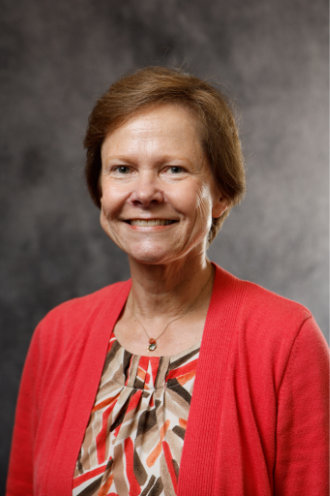Karin Musier-Forsyth, Ph.D.Written by: Glen Borchert, Ph.D.  Dr. Karin Musier-Forsyth is an Ohio Eminent Scholar in Biological Macromolecular Structure in the Department of Chemistry and Biochemistry at The Ohio State University (OSU). She currently serves as the Director of the OSU Center for RNA Biology, an interdisciplinary center consisting of over 40 OSU-based affiliated RNA-focused faculty that facilitates state-of-the-art RNA research. Her lab investigates editing mechanisms of aminoacyl-tRNA synthetases, which involves using biochemical, biophysical, and cell-based approaches to understand the interactions of proteins and tRNAs during protein synthesis, and viral replication, where she primarily focuses on host and viral RNA functions in HIV. Professor Musier-Forsyth grew up in St. Petersburg, FL, attended Eckerd College, and received a bachelor’s degree in chemistry in 1984. She completed her graduate work at Cornell University, earning a Ph.D. in 1989. From 1989-92, Musier-Forsyth conducted research in the laboratory of Paul Schimmel at MIT as an American Cancer Society postdoctoral fellow. In 1993, she was hired as an Assistant Professor at the Department of Chemistry at the University of Minnesota, where she was promoted to an Associate Professor in 1998 and a full Professor in 2003. During her time in Minnesota, Karin received the prestigious Pfizer Award in Enzyme Chemistry from the Biological Division of the American Chemical Society. In 2007, passion for tRNA research led to her current position at The Ohio State University. Her work in diversity inclusion earned Dr. Musier-Forsyth the Diversity Enhancement Faculty Award from OSU in 2020 and Eckerd College has recognized her academic accomplishments with the Carlos F. Barbas III ’85 Alumni Award in 2024. As a Ph.D. student in the Cornell Chemistry Department, Musier-Forsyth worked in the lab of Gordon Hammes. While she did not conduct any RNA research at Cornell, she became an expert in enzyme purification, chemical crosslinking, and biophysical methods including FRET. In 1989, Musier-Forsyth joined Paul Schimmel’s lab in the Biology Department of MIT. Her postdoctoral studies focused on tRNA recognition by aminoacyl-tRNA synthetases (aaRSs). She became enthusiastic about numerous new capabilities in molecular biology, which led her to develop a method called atomic group mutagenesis. The method tests the effect(s) of specific functional groups in minihelix and duplex substrates for aaRSs by incorporating nucleotide analogs into synthetic RNAs. Collectively, these experiences, along with being inspired by Schimmel’s creativity and mentorship, sparked her ongoing interest in aaRS/RNA research. It was during her time at MIT that Musier-Forsyth became intrigued by the role of tRNAs in retroviral replication and the selection of specific tRNAs for reverse transcription in retroviruses – a topic her lab continues to investigate to this day.
As such, it is not surprising that when asked to choose her favorite RNA, Musier-Forsyth selected “tRNA (for obvious reasons!) and the HIV-1 genomic RNA 5’UTR (for its structural and functional versatility and potential as a drug target).” Her favorite article published in the RNA Journal is one of her lab’s classic papers on the packaging of HIV’s RNA genome. This highly cited paper addressed a key question in HIV-1 replication—specifically how is the HIV-1 genomic RNA selected by HIV-1 Gag for packaging into newly budding virions in the presence of a vast excess of cellular RNAs. Commenting on the most exciting project taking place in the lab, Musier-Forsyth described work in collaboration with the Wei-Shau Hu Lab at NIH-Bethesda investigating how transcriptional start-site heterogeneity impacts HIV-1 RNA fate. Here, her group showed that fate of HIV-1 RNA is determined by differences in the 5’UTR RNA structures. Dr. Musier-Forsyth commented: “It’s amazing that a difference of just 2 G residues at the 5’ end of a 9.2 kb RNA can dictate its fate via differences in RNA structure! We are currently working on determining the detailed mechanism by which the structural differences determine RNA translation efficiency.” In addition to her research aspirations, Dr. Musier-Forsyth is passionate about education. “The best thing about an academic career is the opportunity to train the next generation and have an impact on their careers. It’s so rewarding to watch young inexperienced trainees at all stages get excited about science and develop into confident and productive researchers and future leaders.” Impressively, Musier-Forsyth has to date trained 65 graduate students, 40 postdoctoral researchers, and 120 undergraduate researchers in her own lab. Moreover, Musier-Forsyth has been a director or a co-director of multiple NIH T32 pre-doctoral training programs. She currently co-directs (with Dr. Jane Jackman -a previous Spotlightee) the Ohio State Cellular and Molecular Biosciences Program T32, which involves a wide range of standard professional development opportunities, in addition to a required Science Writing course. This course, co-developed and co-taught by Musier-Forsyth, is largely unique in that it covers many genres of science writing (not just grant writing) and is co-taught with Dr. Susan Lang, a Professor of English. Musier-Forsyth recognizes the significant impact that a research mentor and a well-designed training program has on a trainee’s development. Additionally, Musier-Forsyth’s own experiences giving talks at meetings as a trainee led her to note the importance of “sending trainees to conferences such as the Annual RNA Society meeting and giving them opportunities to share their stories and network with the international scientific community.” Finally, when asked about advice she would you give to the next generation of RNA researchers, Musier-Forsyth responded: “Follow your interests and passions and most days you will not feel like you are “going into work”—you are just doing what you want to be doing!” Advice, she herself has clearly followed. |
